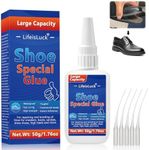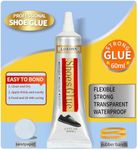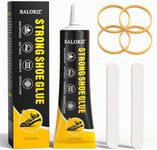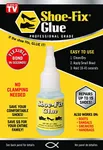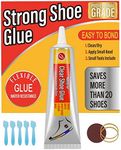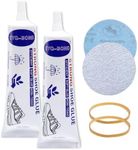Buying Guide for the Best Glue For Shoe Soles
Choosing the right glue for shoe soles is important if you want a strong, long-lasting repair. Not all glues are created equal, and the best choice depends on the type of shoes you have, the materials involved, and how much flexibility and durability you need. Understanding the key features of shoe glues will help you make a smart decision and ensure your shoes stay together through daily wear.Adhesive TypeThe adhesive type refers to the chemical makeup of the glue, such as polyurethane, cyanoacrylate (super glue), or contact cement. This is important because different adhesives bond better with certain materials and offer varying levels of flexibility and water resistance. Polyurethane and contact cement are often preferred for shoe soles because they remain flexible after drying, which is crucial for comfort and durability. Super glue dries hard and can crack with movement, making it less ideal for areas that bend. To pick the right one, consider the materials of your shoe sole and upper—leather, rubber, or synthetic—and choose an adhesive that is recommended for those materials and for flexible bonds.
Drying TimeDrying time is how long the glue takes to set and reach full strength. This matters because a faster drying time means you can use your shoes sooner, but sometimes a slower drying glue forms a stronger, more durable bond. Drying times can range from a few minutes to several hours. If you need a quick fix, look for a fast-setting glue, but for a more permanent repair, a glue with a longer curing time may be better. Think about how urgently you need to use your shoes and balance that with the need for a strong, lasting repair.
Flexibility After CuringFlexibility after curing means how much the glue can bend or flex once it has dried. This is crucial for shoe soles, which need to move with your foot. Some glues dry hard and brittle, which can cause the repair to crack and fail quickly. Others stay flexible, allowing the shoe to move naturally. When choosing a glue, look for one that specifically mentions flexibility or is designed for footwear. If you use your shoes for sports or lots of walking, flexibility is even more important.
Water ResistanceWater resistance refers to how well the glue holds up when exposed to moisture. Shoes are often exposed to rain, puddles, or sweat, so a water-resistant glue will help your repair last longer. Some glues are only suitable for dry conditions, while others are designed to withstand water and even washing. If you expect your shoes to get wet, make sure to choose a glue that is labeled as water-resistant or waterproof.
Application MethodThe application method is how you apply the glue—whether it comes in a tube, bottle, brush, or as a spray. This affects how easy it is to use and how precisely you can apply it. For shoe soles, a tube or bottle with a narrow tip allows for controlled application along seams or edges. If you need to cover a larger area, a brush or spreader might be helpful. Consider how comfortable you are with applying glue and the size of the area you need to repair when choosing the application method.


